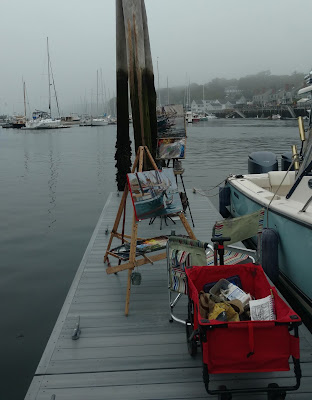And in Camden harbor, there are ropes everywhere.
 |
| Pea Soup, by Carol L. Douglas |
This week is the Camden Classics Cup, which draws all sorts of lovely boats to Camden, Maine (as if the place had any shortage on its own). Howard Gallagher asked artists from Camden Falls Gallery to scamper down to the harbor to paint the beautiful beasties, which I’ll be doing while dodging raindrops. It’s nice to do an event close to home, although it doesn’t happen often.
 |
| Alison and me, in the murk of a foggy day. |
I’ve grown accustomed to the wealth of schooners in the harbor. It was enlightening to see them through fresh eyes. We set up on a floating dock to paint the bow of the Mistress, with Mercantile in the background. Mistress’ dinghy, Tricky Mary, hangs half-suspended from her bow. It’s a nice, odd angle. She’s neither floating nor swinging.
The first time I ever painted in Camden, I was shy about setting up on a floating dock. Still, it’s the only place to paint in places where tides run high. Otherwise, you’ll inevitably get a twist in the hull as the angle changes. Steve Pixley, Camden’s harbormaster, reassured me that it was alright, and I’ve been painting on the docks ever since. This is one of the many ways in which Maine is not like other places.
 |
| Our paintings before the little yawl pulled in. |
Alison was overly impressed by my knowledge of the schooners’ habits. It’s really just a question of asking the crews endless questions, something that’s going to result in my being pitched in the water one of these days. The most important of these is always, “When are you going back out?”
I love the cluster of day-trippers on the wall—Appledore, Olad, and Surprise—but it’s difficult to paint them live, since they’re never in one place long enough. However, in such heavy fog, they make fewer trips.
 |
|
A FitzHugh Lane Day at Camden, Carol L. Douglas. There are boats you can only catchon foggy days.
|
“It’s a real pea-souper,” said a couple coming in from Isleboro to do their weekly shopping. With so many visitors and exotic yachts, it’s easy to forget that for many people, Camden is a working harbor.
By midafternoon, we both needed coffee and lunch. We downed brushes and walked up to town. In retrospect, I feel badly about my choice of dining establishments. Alison has been enjoying such Maine delicacies as Nutella crepes, blueberries and lobster rolls, and I directed her to a boring old chicken salad and a Tootsie Roll. I should have taken her to Harbor Dogs instead. That’s fine coastal dining.
 |
| It draws visitors from around the world, so Camden harbor is never boring. |
We sat on a bench enjoying the sea mist and our lunches when we noticed a little yawl coming in. She tied up right next to our easels and blocked our view. Pretty enough, but at that moment, I hated her. Alison decided she was finished and packed up to head to Port Clyde. I reworked the bottom of my canvas, ruthlessly excising the mizzen mast.
“I’ll see you around someplace,” Alison said. Well, actually, she’ll see me in three weeks at
Adirondack Plein Air. I’m looking forward to it.
I’ve got one more workshop available this summer. Join me for Sea and Sky at Schoodic, August 5-10. We’re strictly limited to twelve, but there are still seats open.











